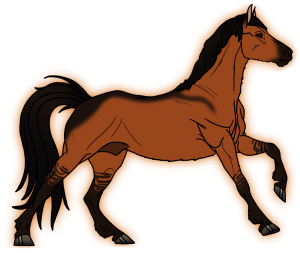Hanese Hotblood
The Hanese hotblood is a small horse, usually only standing at around 14–15HH (142.2–152.4 cm, 56–60 in), and weighing in at around 272.2–294.8 kg (600–650 lbs). They, like most horses, generally live to be 25–30 years of age.
Hanese hotbloods are an old breed, finding their roots in an extinct species of wild horse similar to the Treivan Wild Horse, with their bloodlines almost entirely separate from the various breeds found in Aversia. As a result, they have a primitive appearance that rarely deviates, unless there has been cross breeding with other types of horses. All horses of this breed come in more primitive colors, such as bay and dun, with the occasional chestnut coated horse. Dun horses are the most common, and sport small stripes on their legs along the dark markings near their hocks and knees, dorsal stripes on their backs, and shoulder stripes that extend from the dorsal stripe at the withers, and down over the length of the shoulder. Their manes often stand up straight, though just as many horses have overgrown manes that fall over their necks as well.
They are short, sturdy horses, with short but strong necks and stocky, powerful legs. Despite their size, they make good cart horses, and can pull a lot of weight on their own (often 4x their own body weight can be pulled by a single horse). They are also good riding horses, and do well under saddle, though they are a horse that can take a lot of work to train.
Their coats are rather thick, but they still do well in warmer weather despite this. They shed their coats out depending on the weather, or grow it out if it becomes cold, making them suitable for almost every climate. They have an undercoat, which is the only part that sheds out in warmer climates, often leaving them looking a bit shaggy, as the top coat is naturally longer, so some owners opt to trim the coats down during the warmer months.
Hanese hotblood, as their name suggests, are high-spirited horses that have a lot of energy, which often requires an experienced hand to train and handle them. These horses are generally better mannered and easier to work with when kept at pasture at all times when not working, as keeping them in a stall will often mean the energy is built up and up and the horse will be impossible to work with once let out.
Distribution
Most Hanese hotbloods are found in the central plains, kept in large pastures by their owners. When not being worked, they are essentially feral, and are allowed to roam freely in small bands, each led by a stallion or two. Truly wild hotbloods are found all over Aversia, as some herds have either been let go, or were stolen before eventually escaping. They are considered common.
Habitat
All Hanese hotbloods, regardless if they are tame or feral, prefer wide open spaces, as it allows them to see any predators approaching from a distance. Herds do not generally have a home territory, and will move about during the day for better grazing as well as water, even when there are new foals in the herd.
Diet
These horses are particularly hardy, and are able to survive off just about any kind of plant matter. If it is green, they likely can get some form of nutrients from it, making them ideal for even the harshest of environments. But, if given the choice, they prefer to graze on long grasses that are well watered.
Relations
Hanese hotbloods are often single-person horses, bonding well with one or two people, and often refusing to allow other people on their backs. They are known to buck and rear, and act up when being handled improperly, which means they require an experienced trainer when they are being broken. Once trained, however, they are loyal animals, and will often learn to come when called.
They also work well with other horses of all breeds, though they tend to like to assert their dominance over larger horses, clearly believing they are bigger and tougher than they really are.
Mechanics
- Can pull up to 4x their body weight
- Can survive all types of weather and environments
- Generally only bond with one person
- High speed, medium stamina
- Can be domesticated, even as adults
Material Properties
- Their furs have a variety of uses. The fur in their tails can make excellent rope, and does not require killing the animal to harvest.
- Their meat is edible.
- Mares who have recently have foals can be milked like cows, with a similar kind of milk.
Alchemical Properties
- Undiscovered; likely none.
| Geography • Races • Flora • Fauna • Stones • Metals • Cloth • Foreign Continents |
| The World of Aethius • The Multiverse of Aethier |
